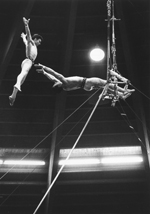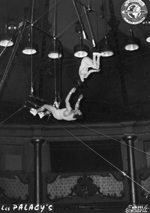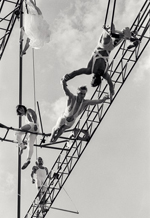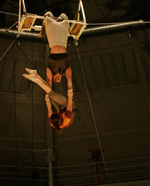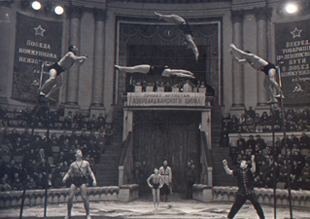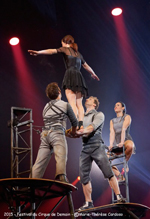The appeal of the void
by Magali Sizorn
Aerial acrobatics with "a catcher" appeared shortly after the flying trapeze act. From the 1870s onward, the Hanlon brothers, famous for their bar-to-bar acrobatics, introduced a dangerous figure that heralded what would later be named the "death jump," in which a balancing flyer dives down to catch the hands of his partner, hanging by his knees from a cradle (Adrian, 1987: 55).
The catcher's work then developed with the introduction of the "catcher's chair" which was fixed (the aerial cradle) or mobile. The cradle, which isoften combined with flying trapeze acts, also became a discipline in its own right. Today, there are two variants of the cradle discipline. The aerial cradle, shored up and attached to the big top cupola, is made of a rectangular metallic frame in which the catcher places his legs and hangs from. The Russian cradle, also called the Korean cradle (it is thanks to the Koreans, trained by Russians such as Marakov, that this exercise is well known), is composed of a crossbow and stands with a platform, on which the catcher stands, attached at the waist, in order to propel the flyer. In Ola Kala by Arts Sauts (2004), two flyers perform in the space available between the arms of 4 catchers, who throw, swing and catch them. Suspended above the void, the flyer only comes up owing to the pull or propulsion of his partner. Beneath the catcher, the acrobat emphasizes the element of space – that which separates him from the ground – and the risk run when he lets go of his partner's hands, above his own shadow.
A matter of life and death
In some ways the circus can be considered a "victim's show" (Routeau, 1980). The cradle acts contributed to this risk aesthetic and the Clerans, a duo from the 1940s and 1950s, left a sad mark on the history of the circus. With neither lunge nor net (which only became obligatory in France in 1956 for exercises practised at a great height that involved letting go), Stephan Hegedus and Charlie Girardin performed the famous death jump in the moments of silence that follow the drumroll. The flyer jumped from the platform carrying out a half-turn to grab the hands of the catcher who was hanging by the backs of his knees. Their legend arose from two tragic events: the fall and death of Charlie Girardin in 1946, followed by that of Stephan Hegedus in 1952. The exercise was taken up again, mainly by the Palacys in the 1960s, this time with a net that enabled other feats of daring (blindfolds, and sequences of jumps and somersaults).
If the possibility of a fall is sometimes overlooked when movements become automatic, the danger of the practice is evoked with every dramatic accident, whenever hands slip, whenever the catcher's wrists are out of reach, or whenever the material breaks.
The Morosof company, laureates of the 2006 young circus talent competition, make these careful rituals of attention to the self and the partner (magnesium on the hands, verbalisations) visible and audible on the Russian cradle in Prochain. Stating every movement in the upcoming acrobatic sequence, the two of them recall the act and visualize its course up until the announced, hoped for "kiss" that ends the sequence.
The cradle is therefore a matter of complementarity, trust, and reciprocal attention. Beyond the swinging, rotation, dislocation, traction and letting go of hands and feet, and beyond the technical aspect of the leap for life (Adrian, 1967: 161), cradle acts are suited to the experience of tension between the high and the low, the heavens and earth, and life and death.
At the edge of the cradle
Circus compositions and narratives are multiple today, exploring diversity in the rapport with the other. The cradle is therefore often practised by couples – Joël Suty and Isona Dodero, Elsa Renoud and Jean-Michel Poitreau from Tout fou to fly (Moreigne, 2002), or male/female duos. Some of them put forward the dynamics of the couple, arguing, letting go and jostling. Others de-sexualise the flyer/catcher relationship, preferring the logic of a duo. The introduction of lunges for low-level work also encourages acrobatic research as a work of acting. On the platform of their Korean cradle, Victoria Martinez and Basile Forest (Cnac class of 2013) hug and kiss. She falls, swings, escapes, then comes back supported by him, acting in the air, under the crossbow and stand, and also on the little stage provided by the platform. Around the cradle, they compose a score in which acrobatic movement is prolonged until the moment traditionally allotted to technical preparation, recuperation, and creating suspense. They thereby take up and also displace the technical and aesthetic conventions of cradle acts, stretching tension throughout their entire performance.
The attraction of void
by Pascal Jacob
Long considered an apparatus developed in North Korea in the 1950s, the Korean cradle is in fact a Russian invention. Created in 1936 by the head of the Simon Arnaoutov company, it remained an innovative and exclusive discipline until it appeared in Western Europe with the first Pyongyang State Circus tours.
It was initially composed of two crossbars and stands facing each other, with two catchers held by straps and stomach belts, working with three flyers. It was a highlight in the programme, half way between an aerial discipline and acrobatics with an apparatus.
The work is powerful and is carried out without safety lines, nets or sometimes even without protective mattresses. Highly influenced by the "petit volant" especially in terms of the distance between crossbars and stands sets, this type of cradle was also incorporated into some "grand volant" acts created in North Korea in the late 1970s and in some major Soviet aerial acts in the 1980s.
Alexandre Arnaoutov, the son of the creator of the apparatus, taught at the National Montreal Circus School where he trained several duos on the cradle. Mark Pieklo and Laura Smith were his first pupils in a line of acts, of which Alexandre Lane and Emilie Fournier embody the continuity today. In 2011, Rafael Moraes and Blancaluz Capella, trained at the CNAC in Châlons-en-Champagne, created E pur si muove, a monodisciplinary show based on the cradle.
From now on, this discipline, taught in western schools of higher education, is designated by the term "Russian cradle."



